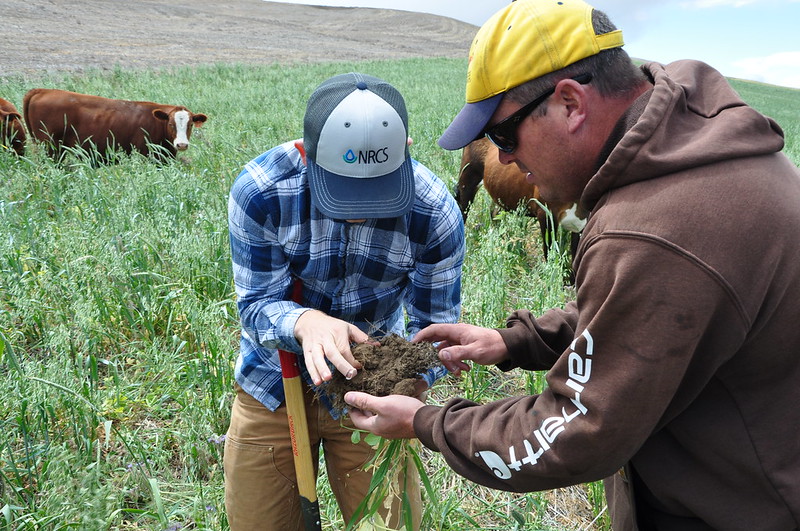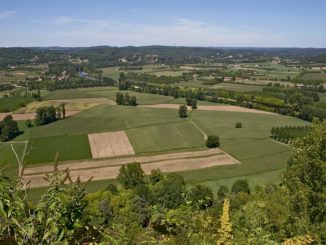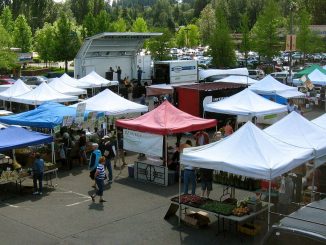
In this three part series we present an analysis by Dr. Andrea Beste on the similarities, differences and synergies between the organic, agroecological and regenerative farming movements. Part three here outlines the relatively new regenerative agriculture movement. A German version of the entire series is also available below.
Beginnings in the USA
In June 2015, some 60 people from 21 nations, including entrepreneurs, farmers and scientists, representatives of educational institutions, policy-makers and NGOs, met in Costa Rica to form an international movement called Regeneration International, committed to a common goal: to reverse global warming and end world hunger by facilitating and accelerating the global transition to a “regenerative agriculture”.
Die gesamte Serie auf Deutsch lesen: Ökolandbau Agrarökologie & regenerative Landwirtschaft
This sounds ambitious. And one could suspect sceptically that this is another new packaging for a “Green Revolution 2.0”, because rhetorically the ladies and gentlemen of industrialised agriculture have been at the same level for years. But it’s not like that: a large part of the co-founders come from the international scene in or around organic farming, even if this was not a prerequisite for founding membership.
The aims of the network are:
– Reversing global warming
– End of world hunger
– Reviving the local economy
– Improving human health and well-being
– Restoring farmers’ independence by ending entrepreneurial control over the global food system.
– regeneration of ecological health, including soil fertility and biodiversity
– Promoting social justice and fair trade i
The objectives are similar to those of the first eco-pioneers in Europe and the agroecology movement, but with a clear focus on the fight against climate change and a more concrete emphasis on independence and fairness than the former European eco-pioneers. This is what the movement has in common with the agroecological movement. There is a great deal of personnel overlap between all three movements.
Comparing Organic, Agroecological and Regenerative Farming part 1 – Organic
If one looks at the roots of the term “regenerative agriculture”, the following passage can be found at Dahlberg 1993 ii: “Regenerative agriculture was formulated in 1983 by Robert Rodale, the founder of the ecological research institute ‘Rodale Institute’. He publicly supported it and later founded a ‘regeneration project’ that encouraged farmers and communities to pursue regenerative approaches.” iii
Christen et al. states: “Regenerative agriculture is an approach in agriculture that rejects pesticides and synthetic fertilizers and is intended to improve the regeneration of the topsoil, biodiversity and the water cycle.” iv
This corresponds almost congruently to the IFOAM principles of organic farming.
Since 2018, the Rodale Institute has also been discussing an US- certification standard for regenerative agriculture with binding standards, which makes organic farming the basis v.
According to Christine Jones vi, however, a regenerative approach goes even further: “Agriculture is regenerative if soils, water cycles, vegetation and productivity continuously improve instead of just maintaining the status. The diversity, quality, vitality and health of the soil, plants, animals and people also improve together“.
In another variation of the theme, in some parts of the English speaking world, the word biological is emerging as a compliment to regenerative. Above, Christine Jones speaks at a biological farming conference earlier this year in Ireland.
In Germany, this system is also called “building-up agriculture” in the spirit of Christine Jones. However, the practice of regenerative agriculture in Germany is often not predominantly communicated as an improvement option within organic agriculture, but rather competes with it. Often the difference to conventional farming is not clearly pronounced.
Certification, Confusion and Competition
Similar to agroecology, the term “regenerative agriculture” is not yet protected officially, nor is there a clear definition on international or national level. Thus, conventional farms can also claim to operate “regeneratively”.
Many advocates of the regenerative approach see this as an advantage. They argue that conventional farms could also be encouraged to operate more sustainably. Only one thing is overlooked: On the one hand, the use of synthetic chemical fertilizers and pesticides can scientifically and practically not be seen as a “regenerative” approach; on the other hand, this inaccuracy in the definition invites (politically motivated) greenwashing.
What is particularly worrying is that confusion has increased in recent years among practitioners, consumers and at the political level. In Germany one often has the feeling that the three terms organic farming, agroecology and regenerative agriculture compete to see which has the best methods. This in turn often makes cooperation more difficult. And this competition can certainly weaken the political implementation of sustainable agricultural models, which must be based on verifiability.
While the words “eco- , organic and bio-” are protected in Europe, the terms “agroecological” or “regenerative” are not. At the European level, it can be observed that decision-makers repeatedly switch to terms such as “regenerative” or “agroecological” if they want to avoid verifiable changes to the system and therefore want to avoid explicitly naming organic farming, because it is clearly defined and leaves no room for interpretation. This is dangerous and undermines the target of a more sustainable approach in agriculture.
Greenwashing and Regenerative Agriculture
One example illustrates the danger of greenwashing very clearly. At the climate summit in New York in September 2019, 19 global corporations formed a coalition for “alternative farming practices”, they call it OP2B, “One Planet Business for Biodiversity”. This coalition was initiated by Emmanuel Faber, Chairman and CEO of the global food and beverage company Danone. Danone is joined by the Balbo Group, Barry Callebaut, DSM, Firmenich, Google, Jacobs Douwe Egberts, the Kellogg Company, Kering, Livelihoods Funds, L’Oreal, Loblaw Companies Limited, Mars, Migros Ticaret, McCain Foods, Nestlé, Symrise, Unilever and Yara.
And although organic farming is known worldwide as the most sustainable agricultural practice, is certified and there is a secure global market for it, the word organic farming is not used once. The term “regenerative agriculture” is introduced as a basic term. There are good reasons for this. The concept of organic agriculture does not fit at all into the business concept of most of the companies gathered here. Just take Yara, the world’s largest producer and trader of mineral fertilizers. Organic agriculture is THE total threat to its business concept.
While the word “organic” is protected in Europe and worldwide, the terms “agro-ecological” or “regenerative” are not. On a European and global level, it can be observed that not only corporations but also decision-makers repeatedly resort to terms such as “regenerative” or “agroecological” if they want to avoid verifiable changes to the system and therefore want to avoid the explicit naming of organic farming, because it is clearly defined and leaves no room for interpretation. This concept of “new framing” poses a great danger to the global organic farming movement, and we must not underestimate this.
i https://regenerationinternational.org/about-us/
ii Dahlberg, K.A. (1993). Regenerative Food Systems: Broadening the Scope and Agenda of Sustainability. Food for the Future (ed. P. Allen), 75-102.
iii https://mk0rodaleinstitydwux.kinstacdn.com/wp-content/uploads/rodale-white-paper.pdf
iv Olaf Christen, Victor Squires, Rattan Lal and Rober J. Hudson (Hrsg.) (2010): Interdisciplinary and Sustainability Issues in Food and Agriculture, Band II.
v https://www.fastcompany.com/40541750/regenerative-organic-certification-wants-to-be-the-ethical-label-to-rule-them-all
vi https://www.amazingcarbon.com/PDF/JONES-RecogniseRelateInnovate.pdf
This article is part of a series. Find part 1 and part 2 below.
Comparing Organic, Agroecological and Regenerative Farming part 1 – Organic
Comparing Organic, Agroecological and Regenerative Farming part 2 – Agroecology
More on regenerative agriculture
Organic Outflanked? Conventional, Biological and Regenerative Challenge(r)s
If Not Meat Then What? Climate Change, Regenerative Ag and Viable Rural Areas
Livestock Will Save Us – A Regenerative Perspective. #LivestockDebate
#SoilMatters part 7 | Soil, Farming and Society: support mechanisms for the necessary transition
#SoilMatters Part 5 | Stuart Meikle on Soil, Ruminants & Sustainable Food
#SoilMatters Part 3 | Soil, Carbon and Policy – where now for 4p1000?







6 Trackbacks / Pingbacks
Comments are closed.